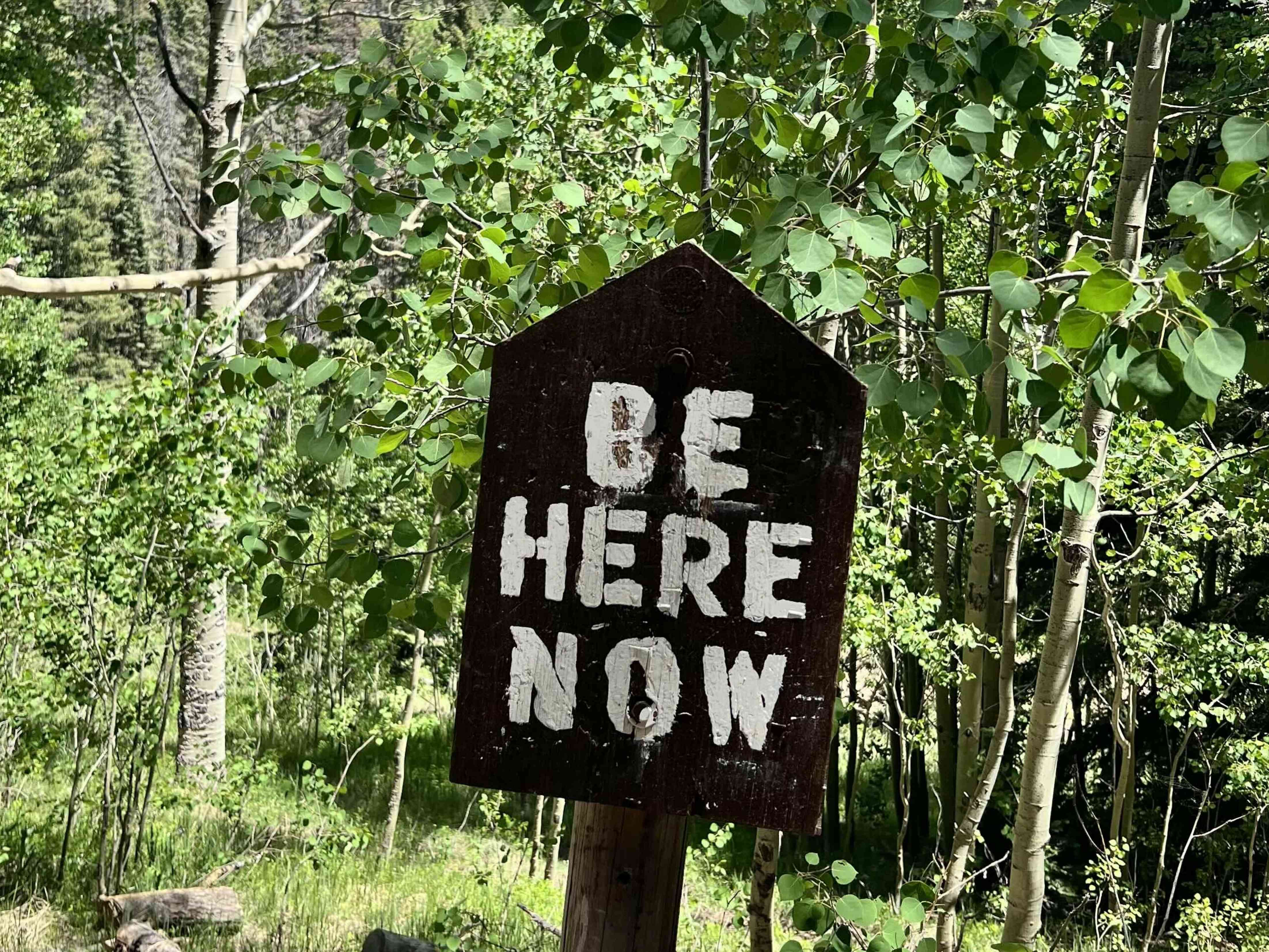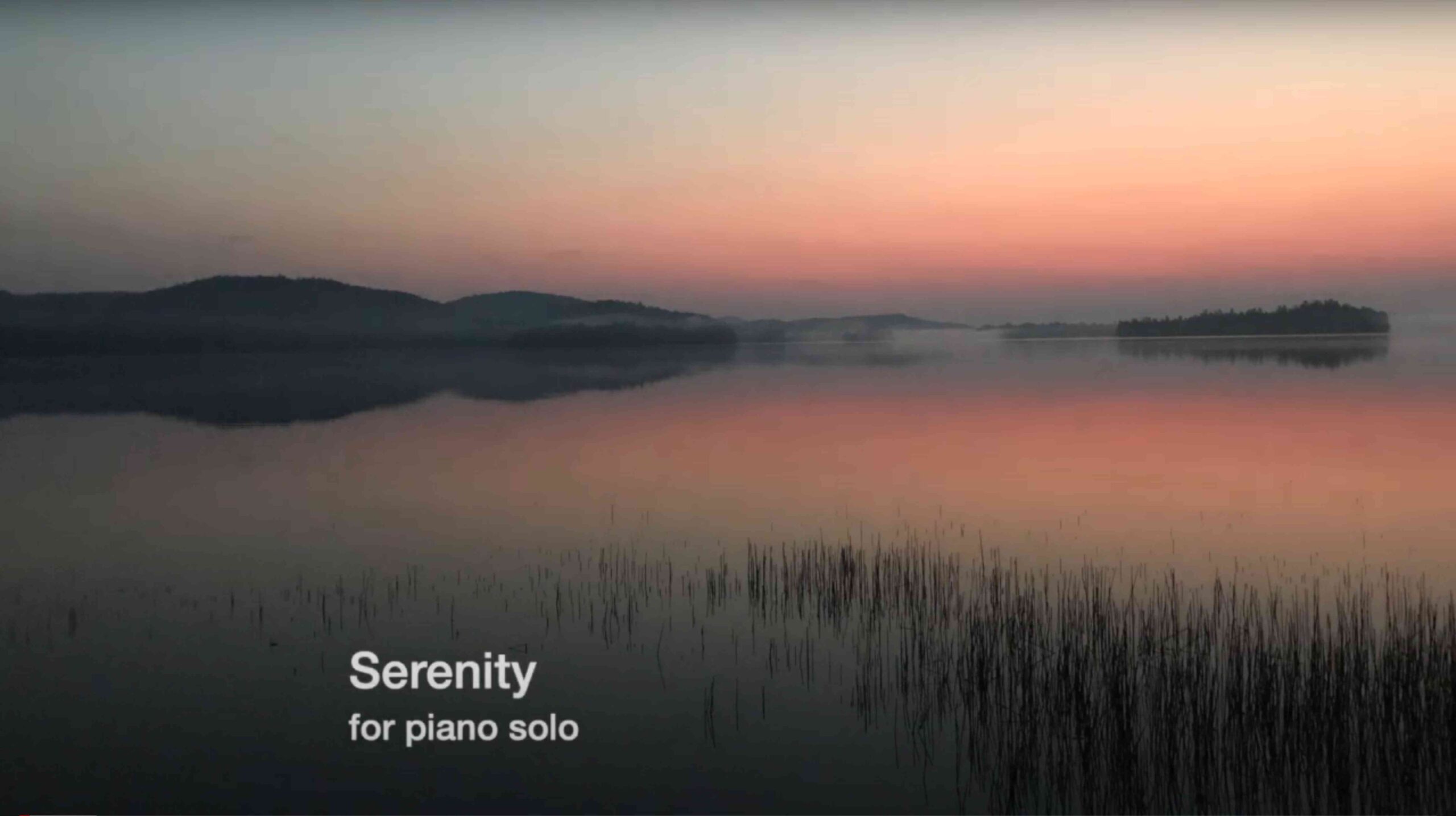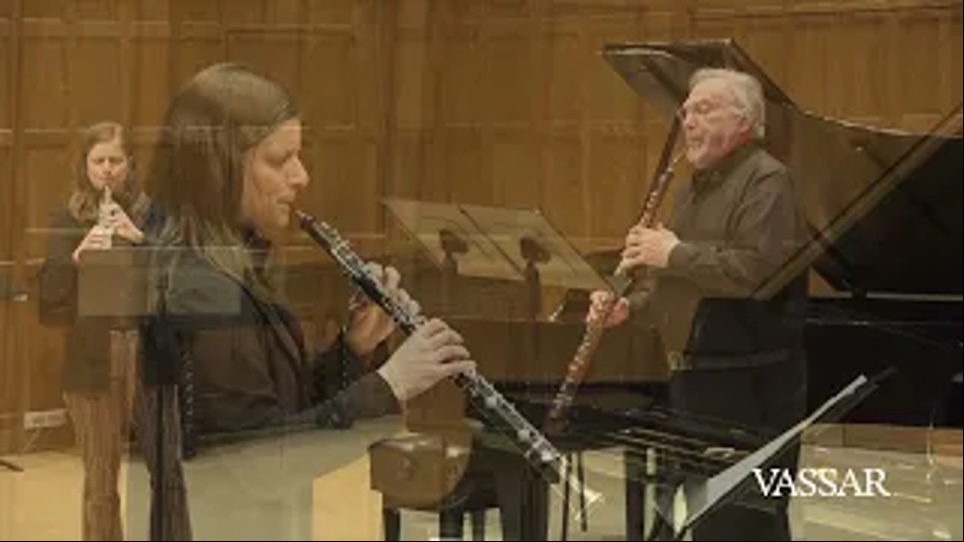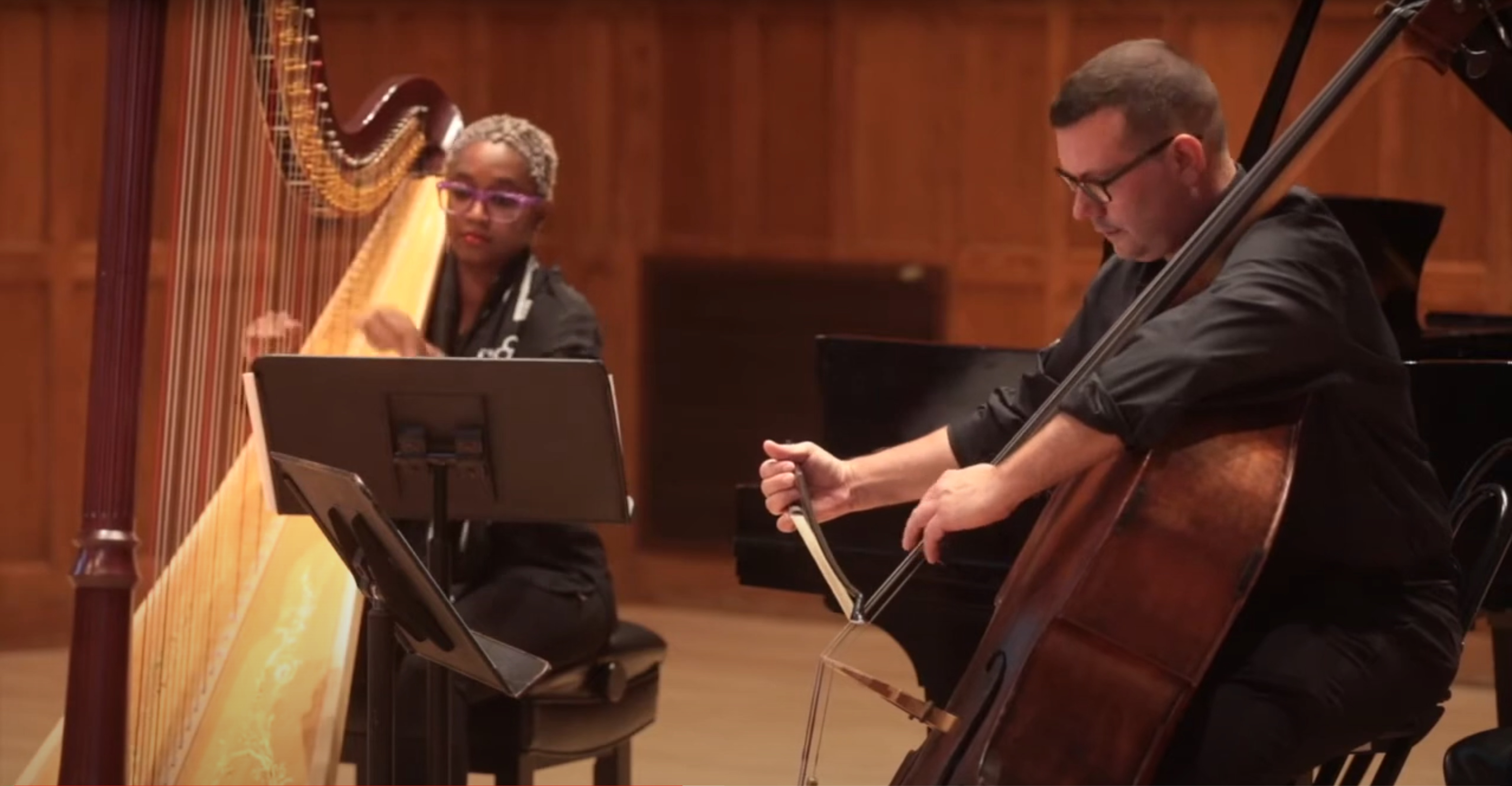Video Playlist
Be Here Now (2024)
Susan Rotholz, flute, Cheryl Bishkoff, oboe, Ian Tyson, clarinet, Peter Reit, French horn, Elisabeth Romano, bassoon, Marka Young & Rachel Handman, violins, Liuh-Wen Ting, viola, Jacob Nordlinger, cello, Daniel Merriman, double bass
Eduardo Navega, conductor
Vassar College
Skinner Recital Hall
Poughkeepsie, NY
September 7, 2024
In one movement
Inspired by sonic imagery found, surprisingly, in a hiking guidebook, the music begins with small groups of hikers setting out at slow but steady and then double-time paces. Soon, instrument groups associate with components of the natural environment: wind instruments with rocks, for instance, and strings with trees. The music responds to guidebook author Edward Henry’s evocations of bellowing boulders, bold staccato rocks, muted forests, lifting melodies, spreading counter-melodies, and harmonizing ridges along the path to a rock promontory in New York’s Shawangunk Mountains known as Gertrude’s Nose. “The crescendos of rock continue to grow, and the forest interludes fade into the background as the land builds to a climax,” culminating in what Henry calls the “final stanza” from the “natural orchestra” (Gunks Trails, 2003).
As for the title of Be Here Now, it comes most directly from a hand-painted sign of mysterious origin greeting hikers near the start of a path to a wilderness area near Santa Fé, New Mexico (appended to the end of this video). The title also borrows from yoga guru Ram Dass’s influential 1971 book of the same title. Its advice to “be here now” is as germane to music listeners as to hikers or yoga practitioners. Forego the distractions of modern life and be fully present in this place and this moment.
Elegy and Affirmation (2002)
Raman Ramakrishnan, cello
Thomas Sauer, piano
Bard College Conservatory
Bitó Building Performance Space
February 4, 2024
1. Elegy
2. Affirmation
Elegy and Affirmation was commissioned through an Iowa Arts Council initiative to mark the first anniversary of the September 11, 2001 terrorist attacks. Its premiere took place at the Blanden Memorial Art Museum in Fort Dodge, Iowa in conjunction with the opening of an exhibition of contemporary art on the subjects of peace and healing. The music’s elegiac first movement and hopeful second movement derive inspiration from diverse sources: a conversation with the mother of a victim of the World Trade Center collapse, a snippet from the nostalgic Stephen Foster tune “Gentle Annie” which serves as the culmination of Elegy, a song sung by Afghan girls returning to school and transcribed from an NPR news report that dominates Affirmation, melodies borrowed from repertories of various bowed string instruments from musical cultures along the Silk Road, and a poem by W.H. Auden. The piece seeks both to mourn our loss and to assert our interconnectedness in the aftermath of the terrorist attacks.
Serenity (2021)
Thomas Sauer, piano
Vassar College
Skinner Recital Hall
Poughkeepsie, NY
January 28, 2023
In one movement
The video begins with a sunrise photo from a kayak camping trip on Lake Lila in New York’s Adirondack Mountains during the early months of COVID. That trip — and the quest for serenity during trying times — inspired the composition.
The music unfolds slowly. An opening peaceful tune harmonized sweetly undergoes a range of melodic and harmonic transformations. Rhythms derive entirely from quarter note values or their multiples, with the exception of grace notes and rolls needed for wide-spanning chords. Contrapuntal techniques of canon (imitating the tune with time delays among multiple parts), inversion (changing descending motions in the melody to ascending ones and vice versa while preserving the size of those motions), and augmentation (lengthening all the notes of the melody by a consistent proportion or amount) delineate one extended section. After a peak of harmonic richness and volume, varied forms of the tune appear leading to a thrice-repeated distillation of the tune into its opening and closing melodic elements. The opening then returns intact followed by a short and quiet coda.
Comets (2021)
Jacquelyn Matava, mezzo-soprano
Samuel Gaskin, piano
Poems by Carole S. Oles
Vassar College
Skinner Recital Hall
June 3, 2022
1. Miss Mitchell’s Comet
2. Maria’s Ghost Considers the Reappearance of Halley’s Comet in 1985
3. Observing Halley’s Comet, 1835
4. Maria Mitchell in the Great Beyond With Marilyn Monroe
5. The Total Eclipse of the Sun
6. Maria’s Ghost Contemplates Her Preservers
Comets is a cycle of six songs for mezzo-soprano and piano drawing on the poetic imagination of Carole Simmons Oles and reflecting on the legacy of 19th-century astronomer Maria Mitchell. Three of the songs use poems Oles wrote drawing from Mitchell’s journals and diaries — about her famous discovery of a previously-unknown comet at the age of 29 in 1847 (#1), her observation (with her amateur astronomer father) of Halley’s Comet in 1835 (#3), and her account of a total eclipse of the sun, for which she traveled to Burlington, Iowa along the Mississippi River in 1869 to observe and measure the event with her female students from Vassar College (#5). The other three songs draw on Oles’s poetic imaginings of a posthumous Maria Mitchell in 1985 encountering Halley’s Comet again with the scientific tools and theories and fears of that latter day (#2), contemplating three women with PhDs working to conserve her legacy (#6), and exchanging thoughts with movie star and pop culture icon Marilyn Monroe, born Norma Jeane Mortenson (#4).
The music for the songs is eclectic and responsive to the texts. Wide-ranging piano arpeggios evoke Mitchell sweeping her telescope across the skies (#1). Propulsive rhythmic drive reinforces fears of human-created environmental calamities (#2). A dreamy reverie expresses wonder at seeing Halley’s Comet (#3). Jazzy interludes match interjections from Marilyn Monroe (#4). Breathless anticipation of the total eclipse contrasts with lyrical evocation of the experience (#5). Paeans of praise and blessing honor three modern-day women preserving Mitchell’s legacy (#6).
Comets, the song cycle, emerged during the coronavirus pandemic of 2020-21. The overwrought treatment of the phrase “keep you from the latest flu” in the final song owes something to this origin.
Frolics (2002)
Claire Chenette, oboe
Joël Evans, English horn
Vassar College
Skinner Recital Hall
February 5, 2022
- Singing
- Chops
- Joke
- Meditation
- Jazz
Frolics, for oboe and English horn, is a set of five character pieces created for the composer’s daughter, Claire Chenette, and her teacher Robert Walters, English horn player in the Cleveland Orchestra. The work is in five movements. Lyricism and trills prevail in “Singing.” “Chops” incorporates fragmentary and virtuosic musical figures. “Joke” pokes fun with discords and grace notes. “Meditation” uses oboe multiphonics as the backdrop for a sonorous and plaintive English horn soliloquy. “Jazz” contrasts a walking line with syncopations and includes wailing solos for each instrument.
Duo Variations for harp & double bass (1991)
Ashley Jackson, harp
Phil Helm, double bass
Vassar College
Skinner Recital Hall
September 23, 2018
In one movement
Duo Variations was composed for John Chiego, former Principal Bassist of the Memphis Symphony Orchestra, who presented its premiere with harpist Jeanmarie Chenette, former Principal Harpist of the Cedar Rapids Symphony Orchestra, at a concert of the Iowa Composers Forum in 1991. Conceived as a set of variations on an original theme, the composition requires the musicians to share particularly closely in the elaboration of the musical materials, with each instrument completing musical thoughts begun by the other. The variations seek to explore different types and degrees of relatedness between the two instruments, along the way revealing some unexpected similarities in performance techniques and timbres.
Eric Hermannson’s Soul: five scenes (1993, reduced orchestration 2013)
Music and libretto by Jonathan Chenette based on the story by Willa Cather
Singers:
Preacher Asa Skinner: Thomas Meglioranza
Margaret Elliott: Courtenay Budd
Eric Hermannson: James Ruff
Orchestra:
Rachel Handman, violin
Jeanmarie Chenette, harp
Frank Cassara, percussion
Susan Brown, piano
Christine Howlett, conductor
Vassar College Skinner Recital Hall, Poughkeepsie, NY
September 23, 2018
1. Prelude – Eric’s Salvation
2. Prairie Autumn
3. Interlude – Asa’s Vigilance
4. One Night of Grace
5. Postlude – Day of Reckoning
Willa Cather published her story “Eric Hermannson’s Soul” in the year 1900 at the age of 27. In the story she juxtaposes three primary characters with their own foibles and yearnings: Preacher Asa Skinner, converted train gambler who knows only the wrath of God and nothing of God’s beauty – who calls down God’s wrath to stifle joyful exuberance wherever he finds it; wealthy Margaret Elliott on a grand tour of the Western plains before marrying into high society back East, who seems to have everything, but yearns for just “one great moment” to give her life meaning beyond its material comforts; and Eric Hermannson, Norwegian immigrant and misfit with nothing but his music to call his own — who loses his voice under Asa Skinner’s domination and recovers it with Margaret. In this early story, Cather demonstrates her distinctive lyricism, her love of the prairie landscape, her passion for art, and her interest in music as one of the freest manifestations of the human soul.
SYNOPSIS of scenes: Eric Hermannson is a young, Norwegian immigrant fiddler working as a farmhand on the Nebraska Divide around the turn of the 20th century. He speaks only haltingly, with great effort, but his music comes easily – indeed, it is the very spark of his soul. As the opera opens (excerpt 1), Eric plays his fiddle to the vast prairies, which echo and respond. Suddenly, the scene is interrupted by the bombast of Asa Skinner, an itinerant Free Gospeller revivalist, for whom fiddling and dancing are the devil’s work. Through pleading and prayer, fervid visions and imperious commands, Asa wears Eric down, until, at the end of the scene, Eric smashes his violin to splinters. Praise the Lord; another soul saved! Throughout this first scene, Eric’s role is portrayed through the music of the solo violin (accompanying a dance double in the original production). All the singing is left to Preacher Skinner. Scene 2 begins two years later, at a farmhouse on the Nebraska Divide. A woman from New York, Margaret Elliott, has come West with her brother to the farm, which their family owns, on a final lark before settling down to genteel married life. In the prologue to the scene, she reflects on the vast beauty of the prairie and the joys of youth (excerpt 2). In subsequent scenes of the opera not included in these excerpts, Margaret encounters Eric and perceives his suppressed soul, resolving to her brother to draw it out. She organizes a dance for that purpose, to be held on the night before she returns to New York. The night of the dance, Asa stands vigilant over his flock (excerpt 3) but Eric escapes to the dance, under Margaret’s spell. Caught up in the spirit of the evening — the spirit of his old life before Asa Skinner — Eric is stunned when Margaret tells him that she must leave the next morning. Imagining that he has given up his soul for this night with her, he decides that he must take all that he can from it. He catches Margaret up in a dance, and then leads her out to the windmill tower, atop which they share a romantic interlude (excerpt 4). In the final scene (excerpt 5), Asa confronts Eric and bemoans the lad’s foolishness for picking his fiddle back up, and thereby setting his soul back a thousand years from God. In dreamy exultation, Eric responds with the only line of poetry he knows, one that he dimly remembers from somewhere: “And a day shall be as a thousand years, and a thousand years as a day.” Asa trudges offstage, while Eric fiddles.
Show less

Comments are
Fantasy & Fugue on BACH (1985)
Anna Elashvili, violin
Yves Dharamraj, cello
Thomas Sauer, piano
Vassar College
Skinner Recital Hall
September 23, 2018
- Fantasy
- Fugue
Fantasy and Fugue on BACH is an homage to J.S. Bach, composed for the Mirecourt Trio in 1985, on the occasion of Bach’s 300th birthday. It re-explore,s in 20th century terms, two of the most exhilarating aspects of Bach’s prodigious musical personality – the incredible flights of fancy and harmonic invention in his toccata and fantasia movements, and the wonderful sense of intellectual play in such masterworks as the Art of Fugue. In the case of this trio, the glue that binds it all together is BACH too – literally, that is, the note order Bb (German B), A, C, and B (German H) – which recurs throughout the work in a variety of guises: as a melody, as a chord, as the basis for a canon or round, played backwards, played simultaneously at different speeds, and finally as the basis for most of the fugue (subject, countersubject, episodes, etc. consisting of transformations of the BACH signature strung together. ) Of course, the idea of basing music on Bach’s name is an old one, originating with Bach himself and recurring in the music of Schumann, Mendelssohn, Reger, Schoenberg, Stravinsky, and literally hundreds of others. My contribution to this vast on-BACH literature is an acknowledgment of the extent to which Bach’s music has taught and inspired me.
Fast Track for flute & guitar (1999)
inspired by the print Fast Track by Sam Gilliam (1992)
Jan Boland, flute
John Dowdall, guitar
Released on CD “Red Cedar Collection: American Music for Flute and Guitar” track 2
Fleur De Son Classics CD FDS57960
In one movement
Fast Track was commissioned by Red Cedar Chamber Music of Marion, Iowa for the Boland-Dowdall Flute and Guitar Duo as part of their Artistic Celebration of the 21st Century. Seven composers were asked to compose music inspired by works of art from the permanent collection of the Cedar Rapids Museum of Art. Each piece was to be brief (three to four-and-a-half minutes), with the whole set premiered at the museum early in the year 2000 in conjunction with an exhibition featuring the selected artworks.
This music for Sam Gilliam’s “Fast Track” draws inspiration from the jazzy energy of the print along with its paradoxical combination of density and airy lightness. Syncopated rhythms and darting melodies abound. The image’s prominent structural element of a circle inscribed in a square led to the opening musical ideas: the guitar’s solid four-note chords built of harmonic fourths and the flute’s constrained, circular melodies. Textured white veils rising from the bottom of the image gave rise to a gravity-defying melodic
figure built of ascending intervals that grow ever larger, which becomes the basis for later sections of the music. In the end, of course, the notes have an energy of their own, but both the music and Gilliam’s image evoke the frenetic pace of life on the fast track.
Broken Ground (1996)
Des Moines Symphony, Joseph Giunta, conductor
Grinnell Singers, John Rommereim, conductor and choral preparation
Tom Meglioranza, baritone soloist
Poems by Ray Young Bear, Michael Carey, Paula Smith, Ed Hirsch, Dan Hunter, and Mary Swander
Civic Center, Des Moines, Iowa
May 11, 1996
- The Ice-Glazed Landscape, poem by Ray Young Bear
- Once When the Ground Was Holy, poem by Michael Carey
- Rhizomes and Flora, poems by Paula Smith and Ed Hirsch
- Ocean of Grass, poem by Ed Hirsch
- When the Ground Was Broken, poems by Dan Hunter and Mary Swander
Broken Ground was commissioned by the Des Moines Symphony Orchestra, the Iowa Sesquicentennial Commission, and Grinnell College in honor of the sesquicentennials in 1996 of the State of Iowa and Grinnell College. Its creation brought together 6 poets, a composer, and a large network of performers and supporters in pursuit of a common goal: to reflect on the relationships between the people and landscape of the prairie Midwest through the arts of music and poetry.
All six collaborating poets write with a distinctive lyricism about the midwestern landscape. They include poet-farmer Michael Carey, Native American poet and novelist Ray Young Bear from the Mesquakie Settlement of the Fox-Sauk Tribe, poet and essayist Mary Swander from Iowa State University whose work often focuses on the Amish culture around Kalona, poet and novelist Paula Smith of the Grinnell College faculty, songwriter and humorist Dan Hunter of Des Moines, and National Book Award-winning poet Ed Hirsch, a Grinnell College graduate from the University of Houston.
Movement 1, “The Ice-Glazed Landscape,” emerges from the icy cold sound of the crotale (small tuned cymbal). The texture thickens gradually and hopefully as the chorus intones the phrase “We lived here once inside and along these ancient hills.” But after this brief moment of warmth, the music settles back into the icy coolness of its opening.
Movement 2 (“Once When the Ground Was Holy”) settles in to a steadier, more energetic motion. The meter is compound — beats subdividing into groups of three notes rather than two — inspired by the playful galloping of the horses described in Carey’s text,. Carey’s line “butcher, baker, beggar man, thief” reappears in Swander’s concluding poem as “butcher, baker, beggarwoman, thief,” and the two lines share similar music.
Movement 3, “Rhizomes and Flora,” weaves together two poems depicting the scenes below and above the prairie surface. Smith’s “silent force… working underground” is depicted through driving rhythms set up by the low brass. Hirsch’s contrasts between native and alien flora are reflected in harmonies that alternate between natural, stable chords and slightly twisted, tension-filled ones. Hirsch’s poem is dedicated to Iowan Amy Clampitt, a MacArthur “Genius” Award recipient and keen observer of nature who died in 1994. The closing line concerning “the shining, cup-flowered grass of Parnassus” leads smoothly back to Smith’s poem with its “waving sea of grasses.”
Movement 4, “Ocean of Grass,” is a poignant and somber meditation on incidents taken from the diaries of prairie frontierswomen and assembled by Hirsch into a poetic structure of great incisiveness. Its villanelle form (19 lines with the first and third lines of the opening stanza appearing alternately as the concluding lines of succeeding stanzas and coming together at the end) gives rise to a musical counterpart. Line 1 is set to a hymn-like depiction of holiness and harshness, while line three is distinguished by an opening point of imitation characterized by the interval of a rising 4th. The hymn-like music, especially, grows gradually richer and more elaborate with each of its recurrences. The movement closes with a dirge-like, slow march accompanying the lines “Think of her sometimes when you pace the earth, our mother, where she was laid to rest.”
“Ocean of Grass,” is a poignant meditation on incidents taken from the diaries of prairie frontierswomen and assembled by poet Edward Hirsch into a poetic villanelle (19 lines with the first and third lines of the opening stanza appearing alternately as the concluding lines of succeeding stanzas and coming together at the end). The music mirrors this form, with line 1 set to a hymn-like depiction of holiness and harshness and line three distinguished by an opening, imitative rising 4th interval. The hymn-like music, especially, grows richer and more elaborate with each of its recurrences. The movement closes with a dirge-like, slow march accompanying the lines “Think of her sometimes when you pace the earth, our mother, where she was laid to rest.”
Movement 5, “When the Ground Was Broken,” begins with Dan Hunter’s “Only the Wind” in energetic, shifting meters driven by a prominent xylophone line. After a quieter, more legato section for the line “Now the stones lie silent and smooth…,” the opening, rhythmic music returns briefly, leading directly to the setting of Mary Swander’s “When the Ground Was Broken.” This closing music involves several fugal sections, echoes of earlier musical and poetic ideas, and an impelling drive towards its energetic conclusion.










